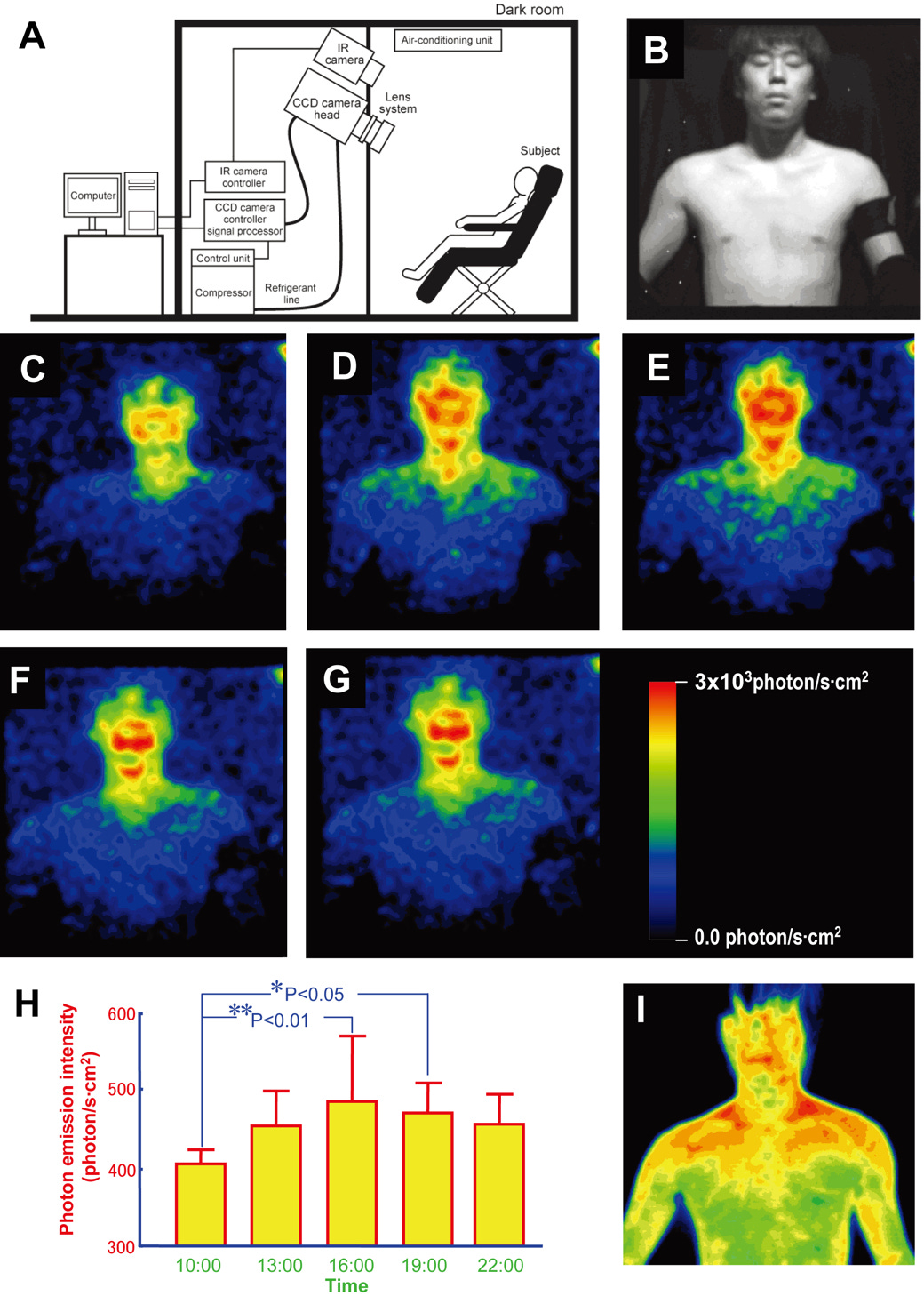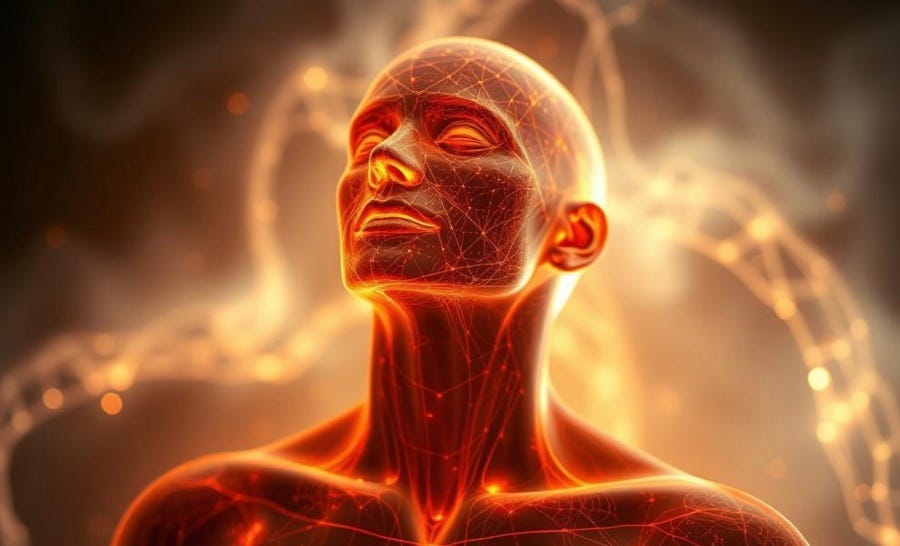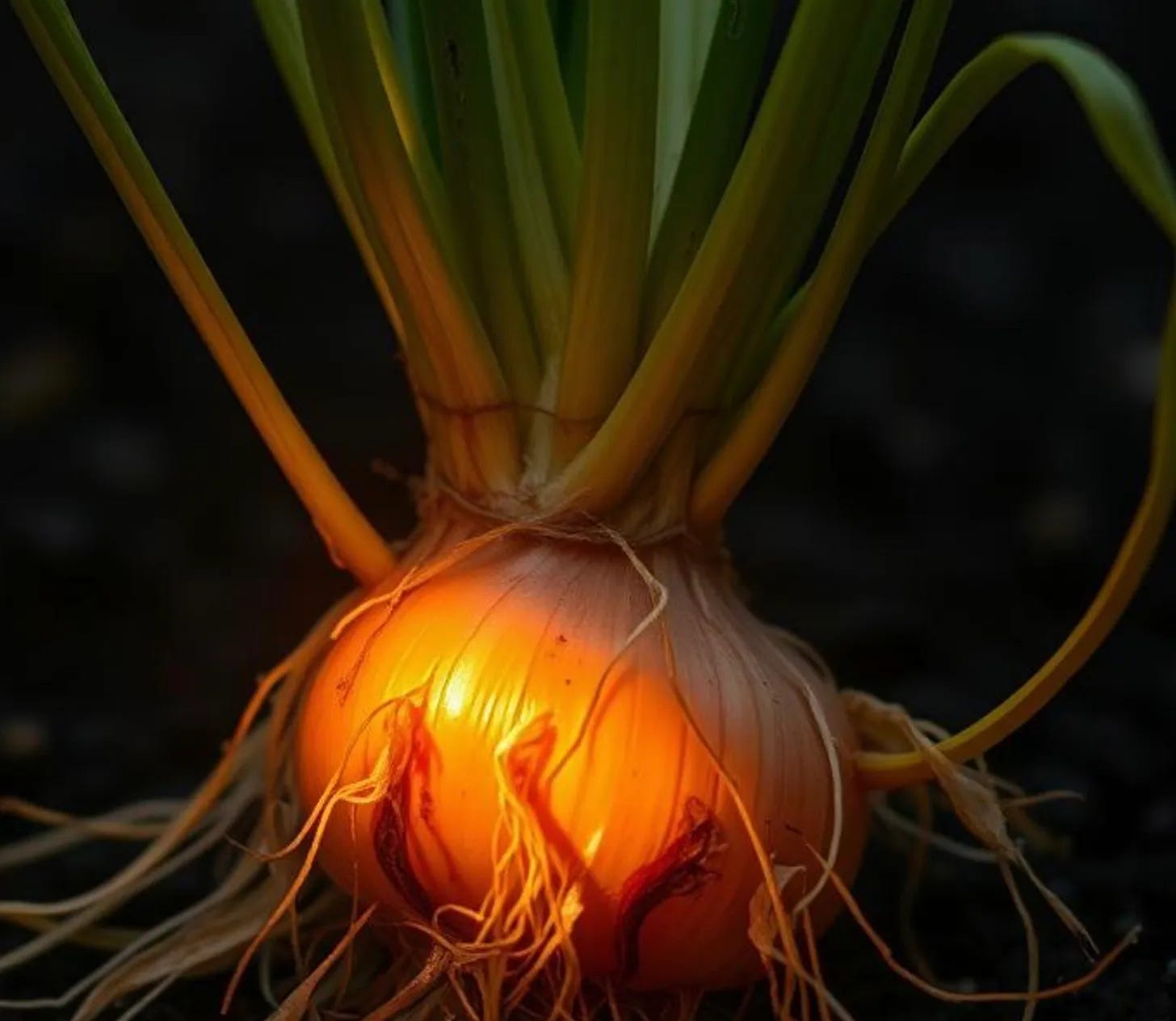Chapter 32: From Glowing Onion Roots to Beings of Light
It sounds like New Agey health term concocted to move wellness products online. At first I paid no attention to the topic of “biophotons” for that very reason, but bear with me. It involves a real story of extraordinary but little-known discoveries.
Scientific revolutions often have humble beginnings. Austrian monk Gregor Mendel studying peas. Naturalist Charles Darwin examining the beaks of finches. Sixteen year-old Albert Einstein imagining himself riding on a beam of light. Swiss chemist Albert Hofmann weaving his bicycle through the morphing streets of Basel after accidentally absorbing a trace amount of LSD through his fingertips.
Add to this lofty list the Russian biologist Alexander Gurwitsch, examining onions in 1923.
In investigating cell division in plants, Gurwitsch found the closer he planted onion roots together, the greater their growth rate. This suggested some form of communication between roots.
Gurwitsch reasoned this signaling would have biological utility, since the detection of other germinating onions nearby would indicate fertile soil. But what could this communication involve? He repeated the experiment with a variety of physical barriers to completely block off the roots, which effectively ruled out chemical communication. Metal and wood dampened the cell division rate to the same level found in isolated onion roots. Glass barriers lowered the rate of growth somewhat, but to his surprise, a quartz divider had no effect at all, as if there was no barrier present.
The Russian biologist understood that quartz blocks ultraviolet rays less than glass. His conclusion: electromagnetic radiation in the form of weak UV emissions must be responsible for the signaling.
It appeared the onion roots were ‘talking’ to each other in the language of light.
A multicellular symphony
Prior to his experiments with onions, Gurwitsch was fascinated with the mystery of embryological development. He believed that a holistic model was needed to explain the precisely timed, symphonic development of living things. It’s a mystery that confounds scientists to this day: how do the exponentially dividing cells in a fertilized egg know where, when and how they are destined to specialize into nerve, muscle or bone cells?
Gurwitsch had released a series of papers theorizing that the seemingly random orientation and division of cells in a developing zygote was given coherence by a “morphogenetic field” that obeyed a regular inverse square law, similar to radiation. He theorized that this field was mediated through what he called “mitogenic rays,” too weak to be detected by scientific instrumentation of the time.
In his experiments with onions, the scientist believed he had identified the culprit: weak ultraviolet emissions.
Today biophoton emissions in the UV to visible light range from living cells - not to be confused with bioluminescence - are accepted by cellular biologists as an empirical given. This is more than vegetable roots saying ‘hey, over here’. “Scientists have found that bacteria, plants, animals and even humans emit biophotons,” observes Catalina Curceanu, a physicist at the National Institute for Nuclear Physics in Frascati, Italy, who is currently investigating biophoton emissions in legumes for indications of “plant intelligence.” A research proposal that would have been laughed out of the lab only a short time ago.
As New Agey as it may sound, it appears that all living creatures, including humans, are fundamentally “beings of light.”

However, don’t expect to see your partner glowing in the dark. The intensity of biophoton emissions is extremely low, at a rate of about 1-1000 photons per square centimetre a second, or about a thousand times less than the sensitivity of the human eye. Or to put it another way, the equivalent to the light of a candle seen from twenty kilometers away. (The images above are the result of capture of a sitting person’s image over several hours in a completely darkened room, using cryogenic charge-coupled device (CCD) camera.)
Biophotons are no different from ordinary photons, the subatomic particles that mediate the electric force. They are photons weakly emitted by biological systems, primarily in the ultraviolet and visible light range of the electromagnetic spectrum.
Beyond that scientifically accepted fact, things become less simple.
The suspected source of biophoton emission is ordinary metabolism —specifically, from the generation of free radicals in living cells. In this process, electrons of biomolecules are elevated to a higher energy state, and when then they drop to their ground state, they emit a photon.
That in itself presents no scientific challenge, but the question is this: do living organisms exploit these photons of UV light for intracellular and/or intercellular communication, for survival-related purposes? Long before biophotons were proven in the lab, Gurwitch answered unambiguously yes, but his own experimental findings were never reproduced to the satisfaction of the scientific establishment.
Enter Dr. Popp
This brings us to the story of Dr. Fritz-Albert Popp, whose life spanned from 1938 to 2018. The German biophysicist became intrigued with the concept of light-emitting organisms after reading the work of the onion-experimenting Gurwitsch. He earned a PhD in theoretical physics from the University of Mainz in 1969, and published eight book and more than 150 scientific articles and studies addressing the cross-disciplinary world of theoretical physics, biology and complementary medicine.
Popp coined the term ‘biophotons’ and is credited with having proved their existence in the mid-seventies. Yet some colleagues condemned his theories as “esoteric” and “outrageous nonsense,” carrying on a lofty tradition of reactionary scientific conservatism, marked by the influential scientist Irving Langmuir’s condemnation of ‘mitogenetic rays’ as an example of “pathological science” in 1953.
Even as late as 2005, Der Spiegel reported that Fritz Schäfer from the Max Planck Institute for Biophysical Chemistry in Göttingen conceded “that ultra-weak cell radiation is a generally accepted fact” and “that the causes of this radiation have not yet been determined,” yet he proclaimed that Popp's theses had been “clearly refuted.”
There were still a few colleagues in German biology circles who hailed the man as a visionary. Among Popp’s early findings was the discovery that some cancer-causing substances have a peculiar property: they ’scramble’ UV light while non-carcinogenic substances do not. Popp found that carcinogenic compounds react to UV light at a frequency of 380 nanometers, absorbing and then re-emitting it at a different frequency. Because this was a consistent property, the German scientist was able to predict which chemicals are carcinogenic based on their interaction with UV light.
Popp wrote up a paper on his discovery, and was encouraged when a prestigious science journal took interest. The intellectual excitement precipitated among scientists by the paper’s publication led to an invitation to speak before cancer specialists at a conference held at the a German Cancer Research Center in Heidelberg.
In his presentation as well as his paper, Popp’s science was unassailable, save for one detail: it assumed that a weak light of 380 nanometres was somehow being produced in the body. To the cancer researchers, this one detail was some kind of a joke. Don’t you think if there were light in the body, they told him, somebody, somewhere would have noticed it by now? - Lynne McTaggart, The Field: The Quest for the Secret Force in the Universe
The rays hadn’t been noticed because they were too weak to be detected by medical instrumentation, Popp rejoined. Turning the tables, he challenged cancer researchers to build equipment sensitive enough to detect these electromagnetic will o’ the whisps.
McTaggart outlines how a student named Bernard Ruth approached Popp to supervise his work for a PhD dissertation. Popp agreed, with the proviso that the student prove that light is emitted from biological tissue.
Ruth thought it a ridiculous suggestion. Of course, there isn’t light in the body.
‘Okay,’ said Popp. ‘So show me evidence that there isn’t light, and you can get your PhD.’
This meeting was fortuitous for Popp because Ruth happened to be an excellent experimental physicist. He set to work building equipment which would demonstrate, once and for all, that no light was emanating from the body. Within two years he’d produced a machine resembling a big X-ray detector…which employed a photomultiplier, enabling it to count light, photon by photon. To this day it is still one of the best pieces of equipment in the field. The machine had to be highly sensitive because it would be measuring what Popp assumed would be extremely weak emissions. - Lynne McTaggart, The Field
In his first series of tests in 1976, the pair put cucumber seedlings into the darkened machine, which picked up photon emissions of surprisingly high intensity from the plants. Both Ruth and Popp suspected this might have something to do with chlorophyll, the molecule responsible for photosynthesis in plants. So they performed their next experiment with potatoes, which couldn’t undergo photosynthesis when grown in the dark. Yet these too registered unusually higher photon emissions, at an even greater intensity than the cucumber seedlings.
What made this even more surprising is Popp’s discovery that the biophotons had a high degree of coherence: that is, the wavelengths were in synch, as in a laser. This quantum property seemed next impossible in the thermodynamically messy environment of a living organism. It was the kind of coherence previously known only in what’s called a “Bose-Einstein condensate,” exemplified by the superconducting properties of certain materials when they are cooled to just a few degrees above absolute zero.
However, it was also exactly what you would expect if biophotons were integrated into some form of biological communication system. Popp was inspired by the thinking of the legendary quantum physicist Erwin Schrödinger, who equated biological energy with information in his 1944 book, What is Life?
“For higher animals,” Schrödinger wrote, “we know the kind of order they feed on; it is the ordered state of matter in the compounds that serve them as food.” And finally: "Plants possess their strongest supply of 'negative entropy' naturally in sunlight.” Popp further developed this idea. Sunlight is an elementary food source for most living beings. It also provides us humans with energy and organizing signals at the cellular level. According to Popp, food is nothing more than light information. In short, we humans are "light feeders.” - Der Speigel, 2005 (translated from German by ChatGPT)
Scientists commonly believe that chemical reactions occur within cells through the random jostling of molecules. But this presents a problem. Estimates suggest 1 billion reactions occur per second in a single eukaryotic cell. In the human body of ~37.2 trillion cells this translates to approximately 37 sextillion reactions per second (that is, 37 thousand billion billion per second).
Timing is the critical factor to pull of this inconceivably complex biochemical choreography. It must be exquisitely precise for a living creature to not collapse into chaos. Popp had begun to believe he had hit upon a fundamental organizing principle in living matter, the means for which this activity is coordinated within and between cells, through resonance and frequency. Popp also believed such a coordination could offer a better understanding of “morphogenesis,” the growth of a single cell into a complete animal, the phenomenon that had fascinated Gurswitch.
This theorized role for biophotons didn’t negate or replace sodium-ion channels, hormones, and all the well-known chemical signaling mechanisms within multicellular creatures. It simply offered a greater breadth of understanding of how organisms function. “Biological phenomena like intracellular and intercellular communication, cell growth and differentiation, interactions among biological systems (like "Gestaltbildung" or swarming), and microbial infections can be understood in terms of biophotons,” insisted Popp.
A legacy of light
It was almost as if scientists had been blithely walking past multiple crime scenes for decades with realizing there was a central suspect involved. Popp believed he had identified the culprit, even if the means of the heist were still unknown.
Within a few years, Popp’s more challenging ideas involving biophotons attracted the ire of the scientific community.
At his university, students wanting to study biophoton emissions began to be censured. By 1980, when Popp’s contract as an assistant professor was finished, the university had an excuse to ask him to leave. Two days before the end of his term, university officials marched into his laboratory and demanded that he surrender all his equipment. Fortunately, Popp had been tipped off about the raid and had hidden his photomultiplier in the basement of the lodgings of a sympathetic student. When he left campus, he left with his precious equipment intact. - Lynne McTaggart, The Field
It got worse. Offered no compensation by the university, the assistant professor had to sue the university to receive his due. Though he won, his career was demolished. A family man with three young children, he could find no university willing to employ him.
He eventually found a position at the Technology Center in Kaiserslautern, which is largely sponsored by government grants for applied science research. “Once again, Popp’s research caused a revolt among the faculty, who demanded his resignation on the grounds that his work was sullying the university’s reputation,” observes Lynn McTaggart.
Then things began to shift…somewhat. Popp found himself at a privately funded research laboratory, which Der spiegel described as residing “in a hut at a former NATO missile base near Neuss, a site that has been repurposed by a patron into a free enclosure for artists.” His work awakened the interest of a select number of researchers and academics outside of Germany, who became associated with his International Institute for Biophysics, centered in his lab.
Popp died in 2018, and though his legacy of biophoton research persists worldwide, his name is rarely invoked by scientists looking for grants, or the scientific media. A 2023 New Scientist article on research work in the field cites the early work of Alexander Gurswitch, but no mention is made of Popp in “The Mystery of the Quantum Lentils.”
Wait, what…lentils?
Yes. A half century after the revelatory findings of Fritz-Popp on biophotons and cancer, and more than a century after Gurswitsch’s paradigm-popping findings on onion roots, you’d think science would be beyond fiddling around with light-emitting plants. Baby steps, I suppose.
Italy’s major nuclear physics lab, The National Laboratory of Frascati, is normally concerned with picking apart atomic nuclei for cosmic secrets, but physicist Cätälina Curceanu has been using the lab’s supersensitive equipment to monitor a small box of lentil seeds, to determine if their weak dribble of photons contains a quantum-level signal.
Notes science writer Thomas Lewton in a December 2023 issue of New Scientist:
Benfatto, Curceanu and their colleagues put their seeds in a black box that shielded them from interference. Outside the box, they mounted an instrument capable of detecting single biophotons. They also had rotating filters that allowed them to detect photons with different wavelengths. All that remained was to set the lentils growing. "We add water and then we wait," says Benfatto. In 2021, they unveiled their initial findings. It turned out that the biophotons' signals changed significantly during the lentils' germination. During the first phase, the photons were emitted in a pattern that repeatedly reset, like a piece of music changing tempo. Then, during the second phase, the emissions took the form of another kind of complex pattern called fractional Brownian motion.
The fact that the lentils' biophoton emissions aren't random is an indication that they could be communicating, says Benfatto. And that's not all. Tantalisingly, the complexity in the second phase of the emissions is mathematically related to the equations of quantum mechanics. For this reason, Benfatto says his team's work hints that signals displaying quantum coherence could have a role in directing lentil germination.
In their 2021 paper in the journal Entropy, Curceanu and her colleagues note that “in the presence of seeds in the chamber anomalous scaling emerges, reminiscent of that found in neuro-physiological processes.”
Seeds behaving like little knots of synapses? “There's something going on there, but we can't claim to know what,” Curceanu told New Scientist. To her credit, the physicist is acknowledging something rather mystifying is afoot.
In a 2005 paper, researchers Schwabl and Klima wrote, “Many open questions remain until a proper understanding of the electromagnetic interaction of the human organism can be achieved: which structures act as receptors and emitters for electromagnetic radiation? How is electromagnetic information received and processed within cells?”
In Part 2, we examine some ideas involving biophotons that are more astounding than calculating legumes.



